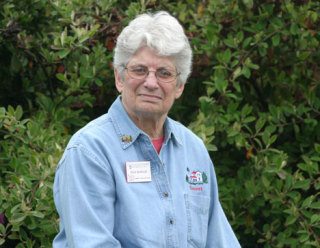At age 82, Doris Northcutt from Greenbank has no intensions of slowing down, giving up or calling it quits.
Northcutt skis, swims, works out, quilts and, since 1995, she’s been part of the volunteer foundation that keeps Admiralty Lighthouse at Fort Casey on a sound footing.
“I went through the Beachwatchers training program and was asked to volunteer as a docent during the season at the lighthouse,” she said recently, following her aqua-arobics session at Freeland’s Island Athletic Club. She also works as an occasional beach monitor at Deception Pass.
Docents are volunteers who support the lighthouse through working in lighthouse-related activities that enhance the Washington State University-run program and the visitors experience.
As a volunteer docent, roughly five times a month Northcutt greets some of the tens of thousands of visitors who trek to the lighthouse each year.
“I tell them about the history and, since I’ve lived in the Pacific Northwest all my life, I know a little history,” she said. “I feel a deep connection to this area. When I talk, I think I have a real understanding about the Northwest.”
She never hesitates to extol the virtues of Whidbey Island, directing people to other attractions, bed-and-breakfasts, restaurants and explaining how the ferry works.
“There are folks visiting from Iowa who have never even been on boat before,” she said. “We want everyone to feel comfortable, take their time and have fun. And come back.”
Of those who come to Fort Casey, her favorites are those who are indeed coming back.
“One fellow lived at the fort when he was a little boy and he was full of stories of remembrance,” she recalled. “And a woman stopped by on a Harley-Davidson while traveling around the country,” Northcutt said. “She had worked for the lighthouse as a student intern long ago and recalled parking her bike — a much smaller motorcycle — in the oil house.”
The small structure, since restored to pristine condition, was used to store the 700 gallons of fuel needed for the families who lived there and to keep the light burning. Before electricity, the lighthouse lamp used whale oil, then mineral or rapeseed oil and eventually kerosene.
She’s lived on Whidbey for 25 years, on waterfront land in Greenbank that she and her husband bought in 1951 for $1,500.
That’s right — $100 down and $10 a month for 10 years.
For 47 years, Northcutt served on the ski patrol at Stevens Pass, retiring just a few years ago. She still fits skiing into her busy schedule whenever she can.
When not giving tours or helping out in the gift shop, she serves on the docent committee that works to improve the exhibits and recently helped write the text for the latest lighthouse brochure.
“We shop for vintage furnishings to remind people that this was a real home for many years,” she said. The dining room is furnished just about the same as it was in the early 1900s, with family portraits, a round oak table and vintage memorabilia in the china closet.
“Local people love to show off the lighthouse to their families and friends. And no wonder; the place sits in an inherently gorgeous setting with the ships going by and the Olympics in the distance,” she said.
Nancy Ries is a second-year docent at Admiralty Head. She described Northcutt as an inspiration.
“She’s constantly amazing me with her breadth of knowledge and great spirit,” Ries said. “She has a wonderful way of dealing with visitors that puts them at ease as they learn about life as it was at Fort Casey.
Sometimes Northcutt gets questions about the fort’s famous 10-inch “disappearing” cannon that were designed to retract below the bluff after firing at enemy ships (though they were never fired in anger).
“I defer those questions to one of the men, ’cause that’s a guy thing,” she said with a grin. “Or I’ll ask sweetly if they’d like to know about the Fresnel lens”
The lens, of course, is the raison d’etre of the lighthouse. The original lens, called a 4th order Fresnel, gave off a constant light through 270 degrees to guide mariners away from the shallow waters below the bluff until 1922. Among the exhibits on display is a rotating bulls-eye lens with intricate glass prisms that concentrated the light and, when rotated, appeared to flash.
“Each lighthouse in Puget Sound has a different characteristic as an aid to navigation,” Northcutt explained.
She added that being a volunteer keeps her alive and aware of the world around her.
“Meeting all those wonderful people is a terrific way to stay young,” she said.
Docent volunteer coordinator Gloria Wahlin said Northcutt brings a ton of energy to the job.
“She’s willing to paint or clean, whatever is needed,” she said. “All our volunteers feel a sense of ownership to the lighthouse and, frankly, without them we would have to close down.”
Anyone interested in volunteering can call the lighthouse at 360-240-5584, e-mail AdmiraltyHeadLighthouse@gmail.com or visit www.admiraltyhead.wsu.edu.



